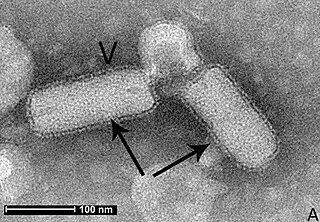
Flaviviridae is a family of enveloped positive-strand RNA viruses which mainly infect mammals and birds. They are primarily spread through arthropod vectors. The family gets its name from the yellow fever virus; flavus is Latin for "yellow", and yellow fever in turn was named because of its propensity to cause jaundice in victims. There are 89 species in the family divided among four genera. Diseases associated with the group include: hepatitis (hepaciviruses), hemorrhagic syndromes, fatal mucosal disease (pestiviruses), hemorrhagic fever, encephalitis, and the birth defect microcephaly (flaviviruses).

Morbillivirus is a genus of viruses in the order Mononegavirales, in the family Paramyxoviridae. Humans, dogs, cats, cattle, seals, and cetaceans serve as natural hosts. This genus includes six species, with a seventh species being extinct. Diseases in humans associated with viruses classified in this genus include measles; in animals, they include acute febrile respiratory tract infection and Canine distemper. In 2013, a wave of increased death among the Common bottlenose dolphin population was attributed to morbillivirus.

Rhabdoviridae is a family of negative-strand RNA viruses in the order Mononegavirales. Vertebrates, invertebrates, plants, fungi and protozoans serve as natural hosts. Diseases associated with member viruses include rabies encephalitis caused by the rabies virus, and flu-like symptoms in humans caused by vesiculoviruses. The name is derived from Ancient Greek rhabdos, meaning rod, referring to the shape of the viral particles. The family has 40 genera, most assigned to three subfamilies.

Tymoviridae is a family of single-stranded positive sense RNA viruses in the order Tymovirales. Plants serve as natural hosts. There are 42 species in this family, assigned to three genera, with two species unassigned to a genus.
Gammaflexiviridae is a family of viruses in the order Tymovirales. Fungi serve as natural hosts. There is only one genus in the family, Mycoflexivirus, which has one species: Botrytis virus F.

Nyavirus is a genus of negative-strand RNA viruses in the family Nyamiviridae. Ticks and birds serve as natural hosts. There are four species in this genus.

Seadornavirus is a genus of viruses, in the family Reoviridae, in the subfamily Sedoreovirinae. Human, cattle, pig, and mosquitoes serve as natural hosts. There are three species in this genus: Banna virus (BAV), Kadipiro virus and Liao ning virus. Each of these viruses has been isolated from Aedes, Anopheles and Culex mosquito populations, but only BAV has been shown to cause infection in humans, in which the symptoms are similar to Japanese encephalitis—fever, malaise and encephalitis. The word seadornavirus is an portmanteau, meaning Southeast Asian dodeca RNA virus.

Aquareovirus is a genus of double-stranded RNA viruses in the family Reoviridae and subfamily Spinareovirinae. Fish, shellfish, and crustacean species serve as natural hosts. Aquareoviruses in general have low or no pathogenicity for fish. However, some cause hemorrhagic disease, hepatitis and pancreatitis. Grass carp hemorrhage virus is the most pathogenic aquareovirus. There are seven species in this genus.

Cytorhabdovirus is a genus of viruses in the family Rhabdoviridae, order Mononegavirales. Plants serve as natural hosts.
Entomobirnavirus is a genus of viruses in the family Birnaviridae. Its natural host is the fly Drosophila melanogaster. There are two species in this genus.

Respirovirus is a genus of viruses in the order Mononegavirales, in the family Paramyxoviridae. Rodents and human serve as natural hosts. There are seven species in this genus. Diseases associated with this genus include: croup and other acute febrile respiratory tract infections.

Megabirnaviridae is a family of double-stranded RNA viruses with one genus Megabirnavirus which infects fungi. The group name derives from member's bipartite dsRNA genome and mega that is greater genome size than families Birnaviridae and Picobirnaviridae. There is only one species in this family: Rosellinia necatrix megabirnavirus 1. Diseases associated with this family include: reduced host virulence.

Nyamiviridae is a family of negative-strand RNA viruses in the order Mononegavirales. Ecdysozoa and birds serve as natural hosts. The name is a portmanteau of Nyamanini Pan and Midway Atoll and the suffix -viridae used to denote a virus family. There are seven genera in this family.
Aquaparamyxovirus is a genus of viruses in the family Paramyxoviridae, order Mononegavirales. The genus includes two species. Fish serve as the natural hosts for AsaPV, in which the virus may cause proliferative gill inflammation.

Dinovernavirus is a genus of double-stranded RNA viruses in the family Reoviridae and subfamily Spinareovirinae. Member viruses replicate in a variety of mosquito cell lines. The name is an abbreviation for double-stranded, insect, novem, rna virus. There is one species in the genus: Aedes pseudoscutellaris reovirus.
Hunnivirus is a genus of viruses in the order Picornavirales, in the family Picornaviridae. Cattle serve as natural hosts. There is only one species in this genus: Hunnivirus A.
Perhabdovirus is a genus of viruses in the family Rhabdoviridae, order Mononegavirales. Fish serve as natural hosts. Diseases associated with viruses of this genus include: breathing and swimming problems.
Sprivivirus is a genus of viruses in the family Rhabdoviridae, order Mononegavirales. Fish serve as natural hosts.

Tibrovirus is a poorly characterized genus of viruses in the family Rhabdoviridae, order Mononegavirales. There are 8 members of the genus. Tibroviruses have been isolated from biting midges, cattle, and humans. None of the tibroviruses, except for Bas-Congo virus, have been associated with any diseases.
Tupavirus is a genus of viruses in the family Rhabdoviridae, order Mononegavirales.












